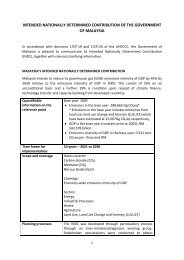RP-01638
RP-01638
RP-01638
Create successful ePaper yourself
Turn your PDF publications into a flip-book with our unique Google optimized e-Paper software.
Economic Analysis and<br />
Potential Markets<br />
Tan Bock Thiam<br />
Of the people in developing countries, 75%<br />
do not have access to adequate supplies of<br />
clean water (IRC 1982). The use of handpumps<br />
in areas where there are adequate<br />
supplies of ground water is the simplest, least<br />
costly method of providing the rural population<br />
with clean water. As increased attention<br />
is paid by governments and international<br />
organizations to the provision of safe sources<br />
of drinking water to the people in the rural<br />
areas, the demand for handpumps in nearly<br />
all developing countries will increase.<br />
The potential market in these countries has<br />
been estimated at 20 million for this decade<br />
(Modern Asia 1982). However, although there<br />
is an obvious demand for handpumps, the<br />
installation rate of these pumps appears to be<br />
hindered by the lack of a pump that can be<br />
maintained easily at the village level. Such a<br />
pump, which is ideally suited for the rural<br />
areas, is described as a village-level operation<br />
and maintenance (VLOM) pump.<br />
The average maintenance cost for handpumps<br />
in East Africa is $4001 per pump per<br />
year (World Water 1982). In some instances,<br />
the maintenance cost accounts for 85% of the<br />
amortized cost of installing a rural-water<br />
supply. Thus, although the use of handpumps<br />
offers a low-cost alternative to the provision<br />
of clean water in rural areas, the high<br />
incidence of pump breakdown and the problem<br />
of providing adequate maintenance deter<br />
the wider use of these pumps in rural areas.<br />
The objectives of this study were threefold:<br />
first, to conduct a financial and economic<br />
analysis of the cost effectiveness of the polyvinyl<br />
chloride (PVC) handpumps being tested<br />
by the International Development Research<br />
1AII costs are in US$. The exchange rates used here<br />
are: US$1.00 = $2.30 Malaysian, P8.50 Philippines,<br />
B23.00 Thailand, and R20.00 Sri Lanka.<br />
Centre (IDRC) network, as compared with<br />
other handpumps in use in these countries;<br />
second, to analyze the sources of water<br />
supply for rural areas and make projections<br />
regarding the percentage of rural households<br />
to be served by piped water by the year 1990;<br />
and, third, to undertake a preliminary assessment<br />
of the market for handpumps for the<br />
next 10 years and assess the potential market<br />
for the handpump being tested by the network<br />
in these four countries.<br />
Some of the information on the cost of the<br />
handpumps was obtained from the project<br />
interim reports. Additional information was<br />
secured using a questionnaire and from<br />
discussions with the project leaders in each of<br />
the four countries. Information on the second<br />
and third objectives of this study was gathered<br />
from interviews with the project leaders,<br />
government officials, and other interested<br />
individuals from various organizations.<br />
One of the major limitations of this study<br />
was the limited time spent in Sri Lanka, Thailand,<br />
and the Philippines. Therefore, it was<br />
possible to obtain only a preliminary assessment<br />
of the overall situation regarding rural<br />
water supply in general, and the role of<br />
handpumps in particular. Nevertheless, with<br />
the active cooperation of each country's<br />
project team and information obtained from<br />
interviews and published sources, it was<br />
possible to arrive at a fair assessment of the<br />
situation prevailing in these four countries.<br />
The cost information available for the<br />
IDRC-PVC pumps was for experimental or<br />
individually fabricated units. Thus, it was not<br />
meaningful to use the data for comparison<br />
with other pumps produced on a large scale.<br />
It was only possible in one country (Malaysia)<br />
to obtain the estimated cost of the PVC pump<br />
if it were to be produced in large quantities.<br />
Thus, a detailed financial analysis was only<br />
carried out for Malaysia because of the Jack of<br />
data from the other countries.<br />
SriLanka<br />
Country Analysis<br />
The project team installed about 21 pumps,<br />
primarily in the southern part of the Island.<br />
Each pump served a cluster of four to five<br />
households or about 30 people. All the pumps<br />
that were installed are still functioning and<br />
they are being maintained by the Sarvodaya<br />
57



